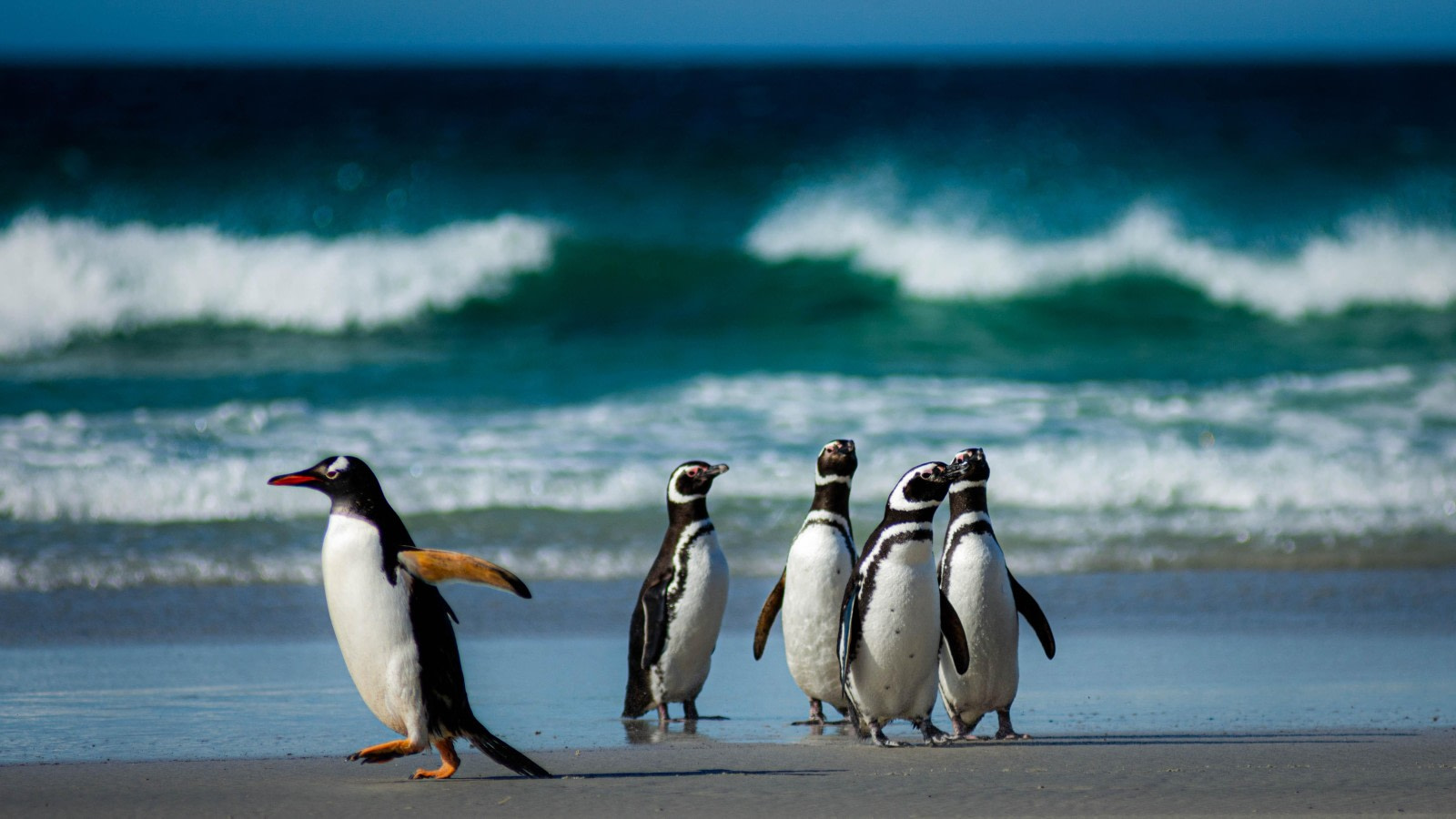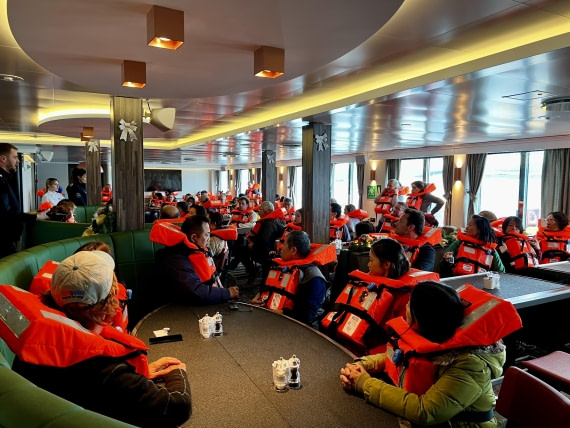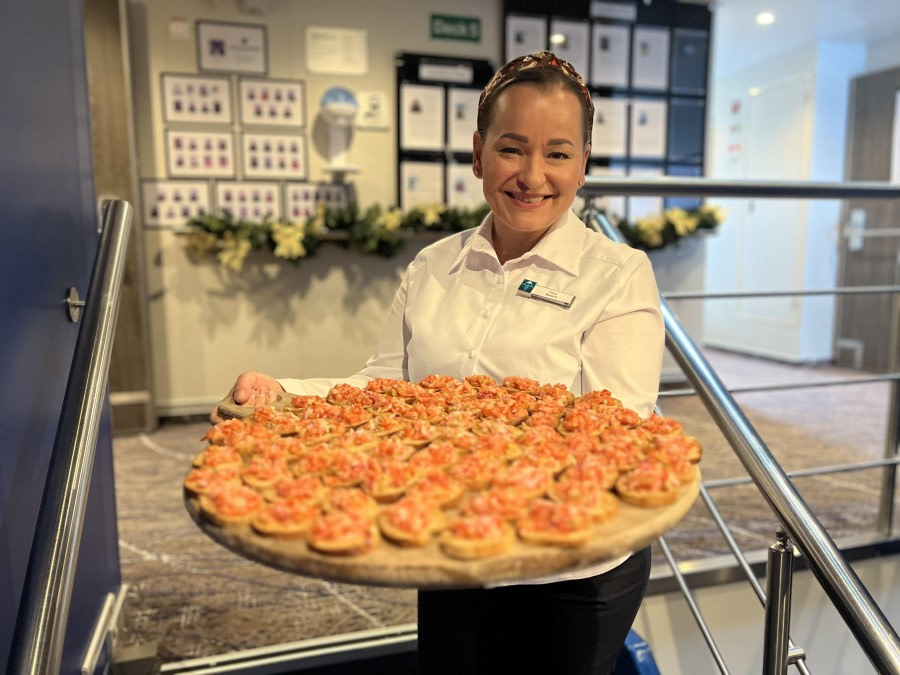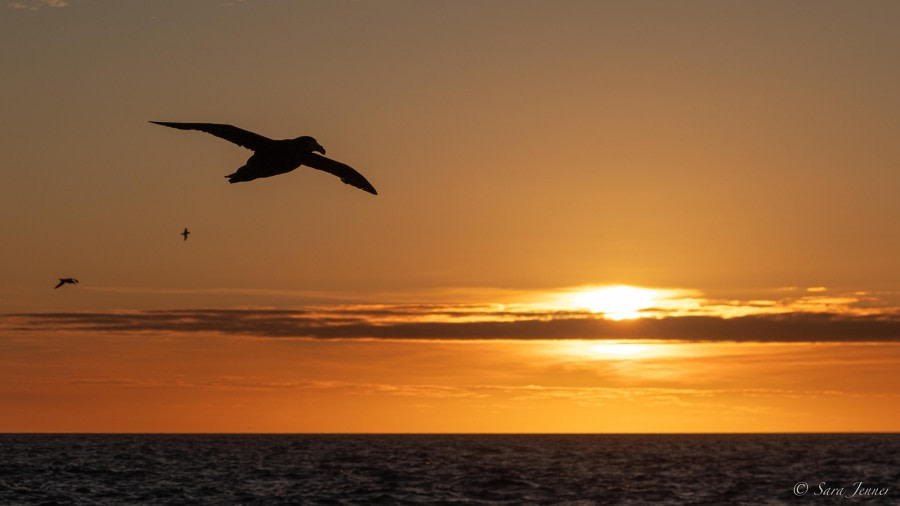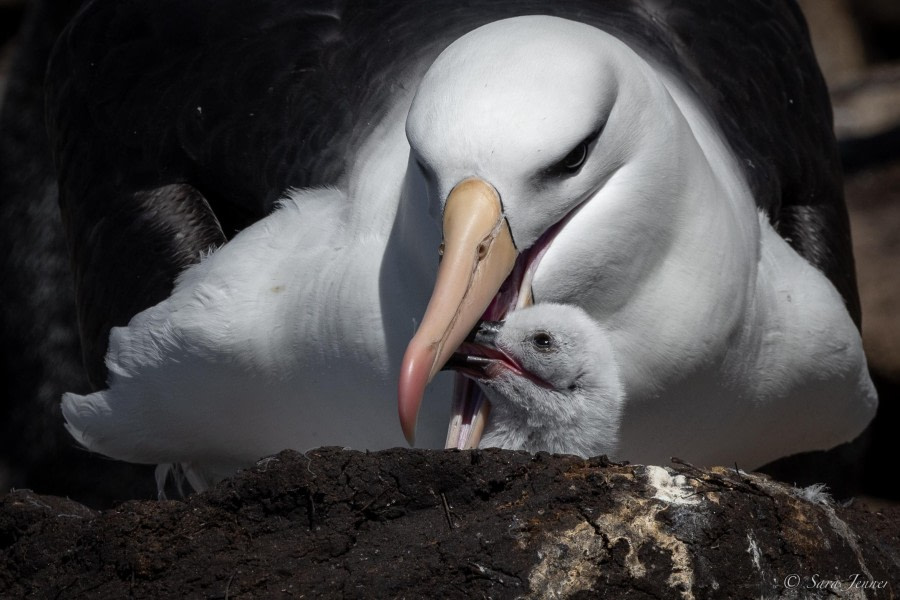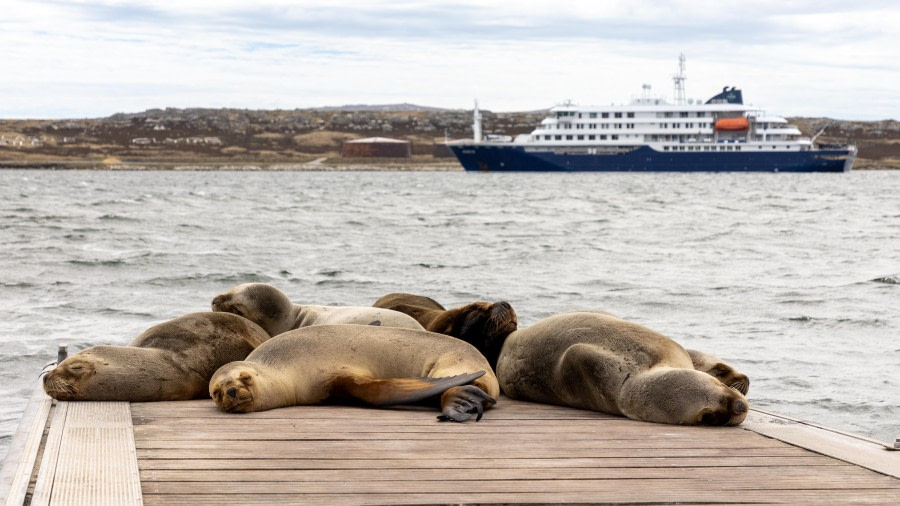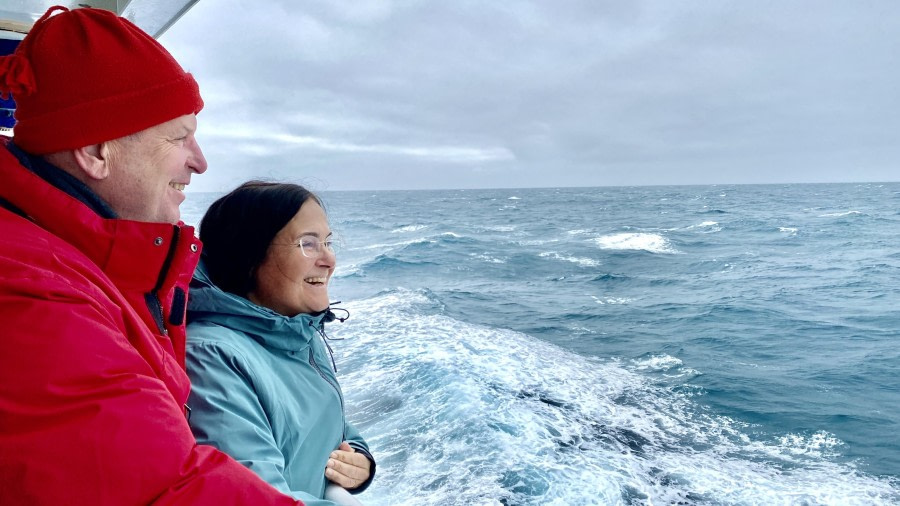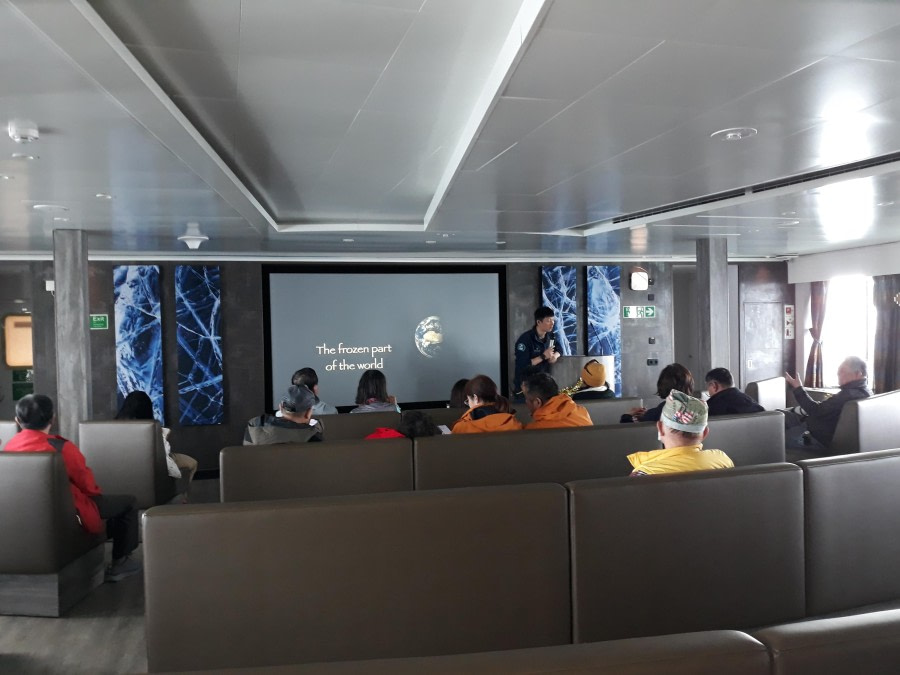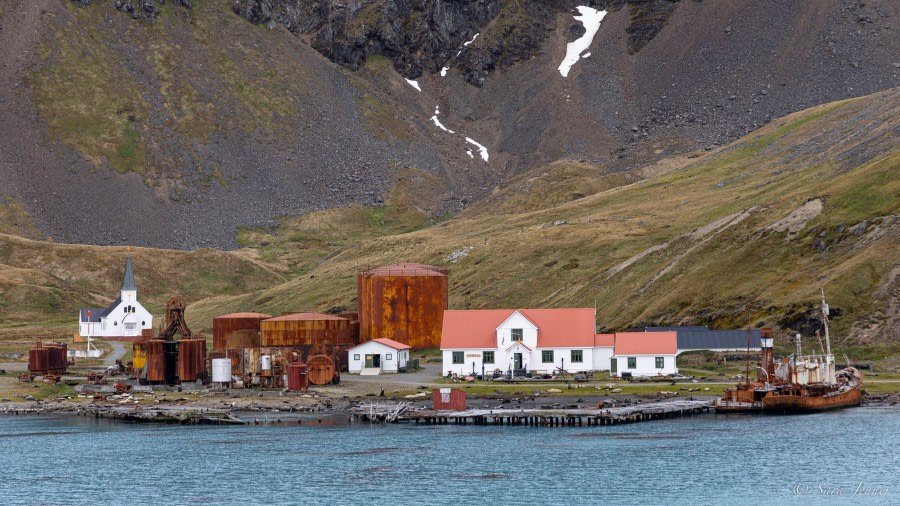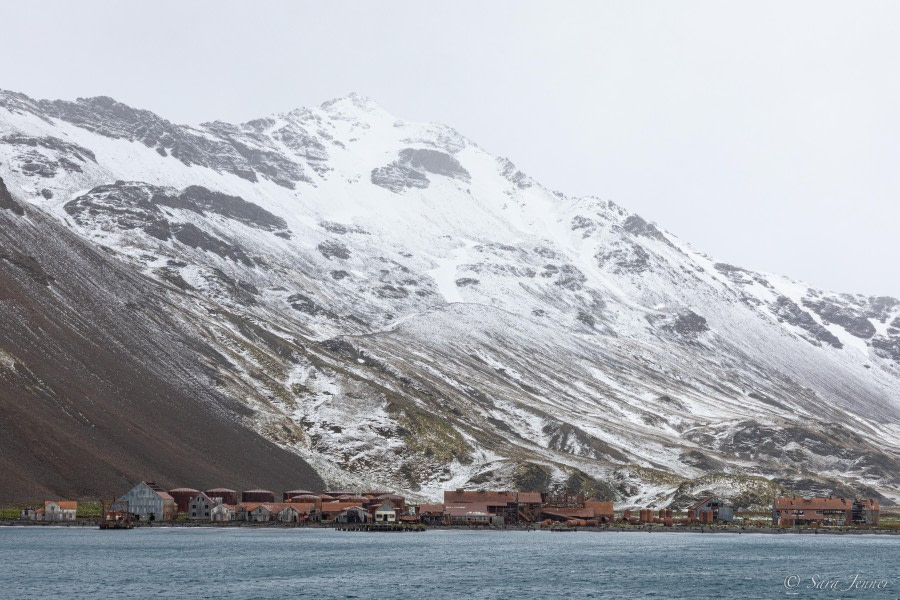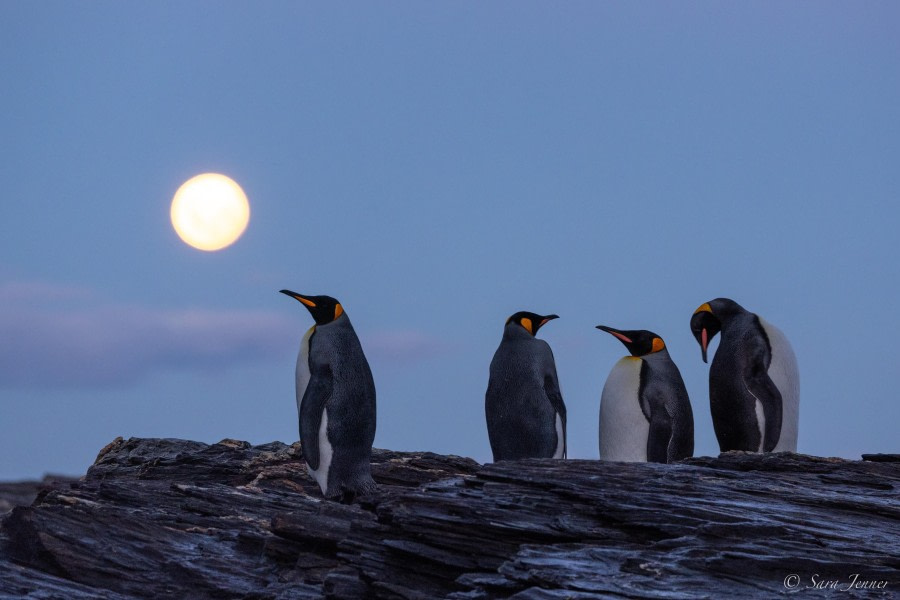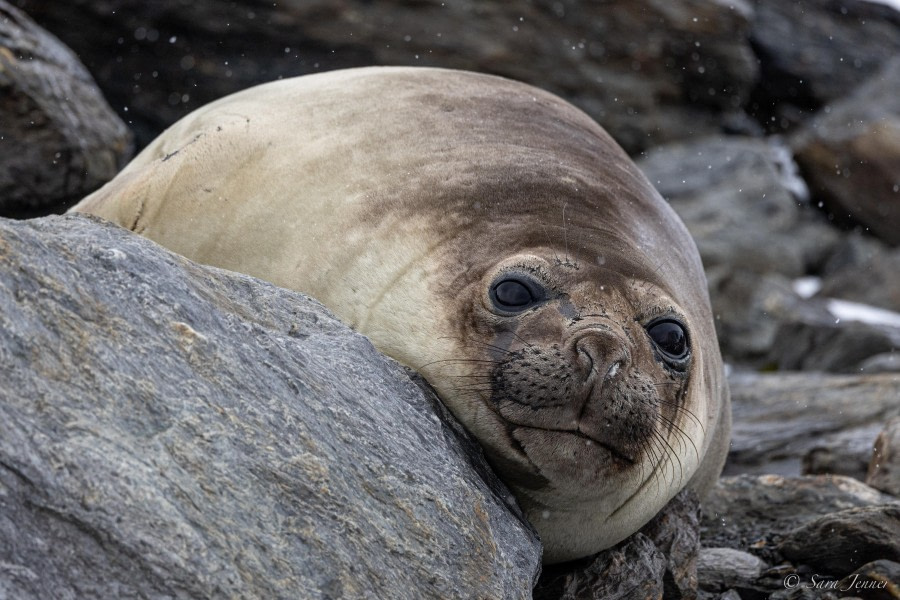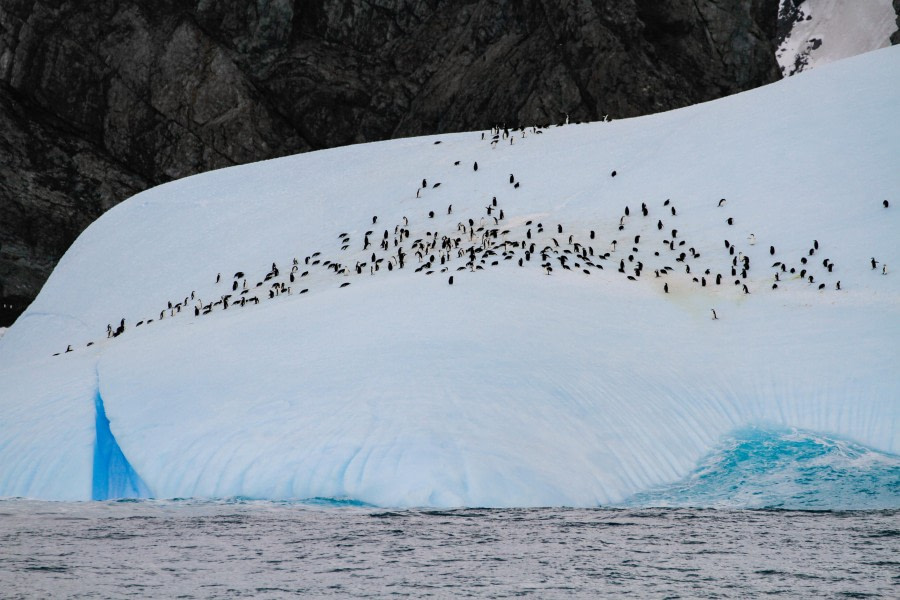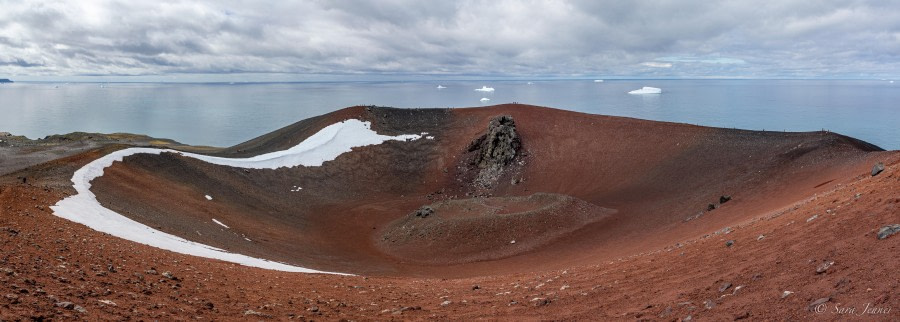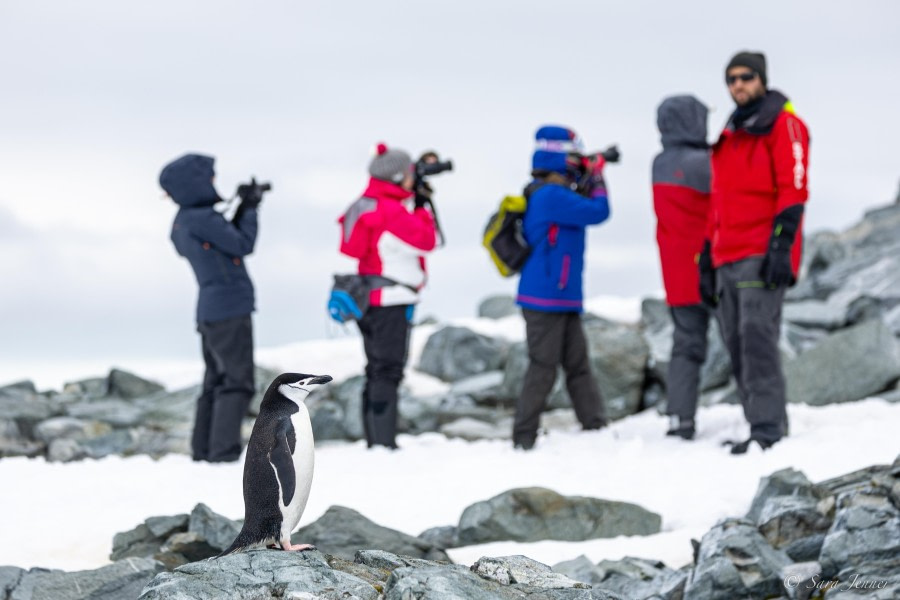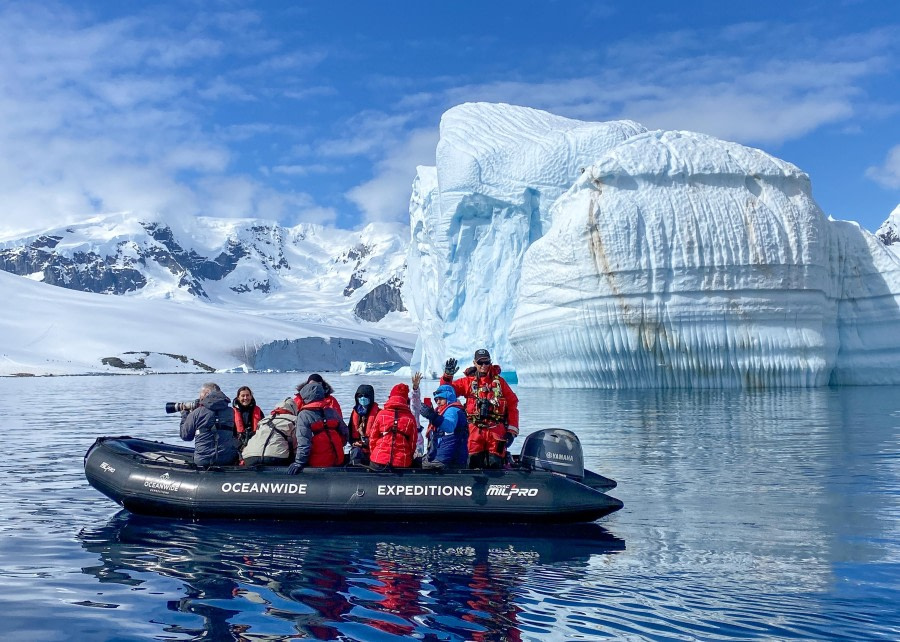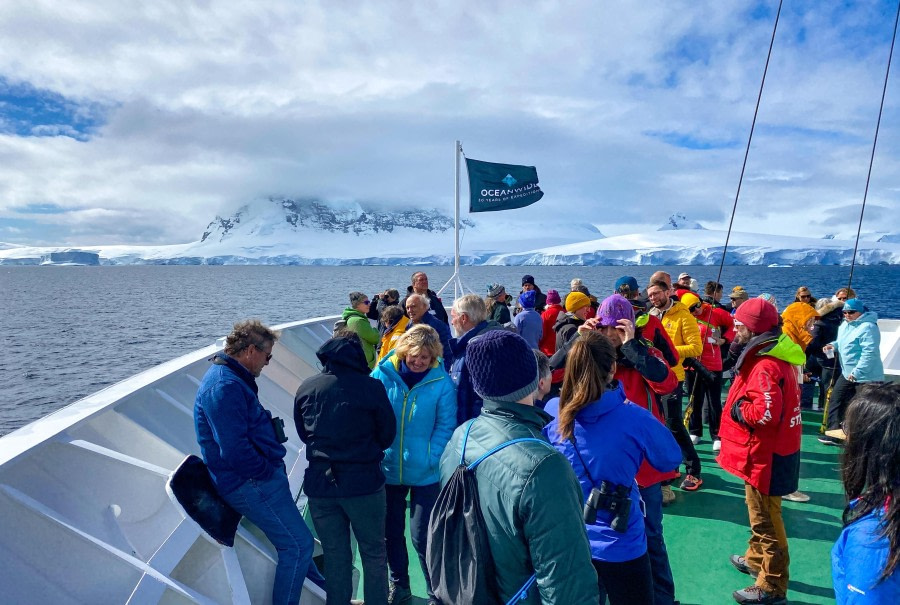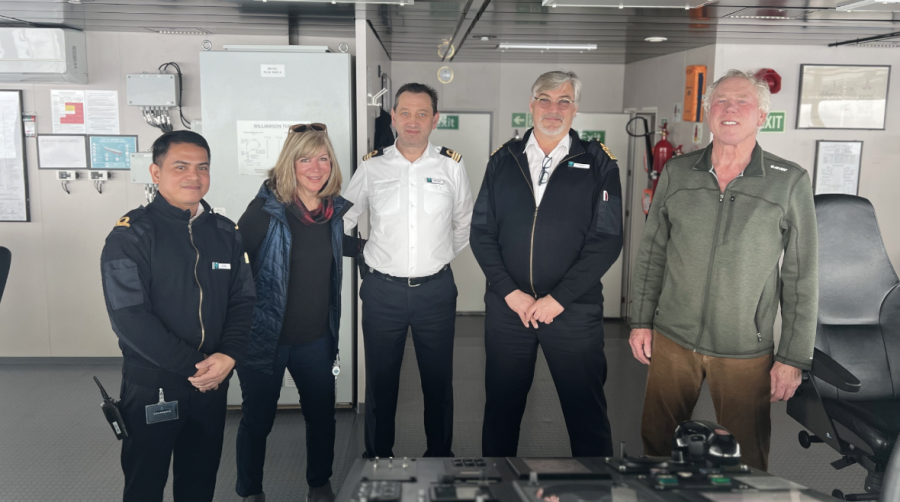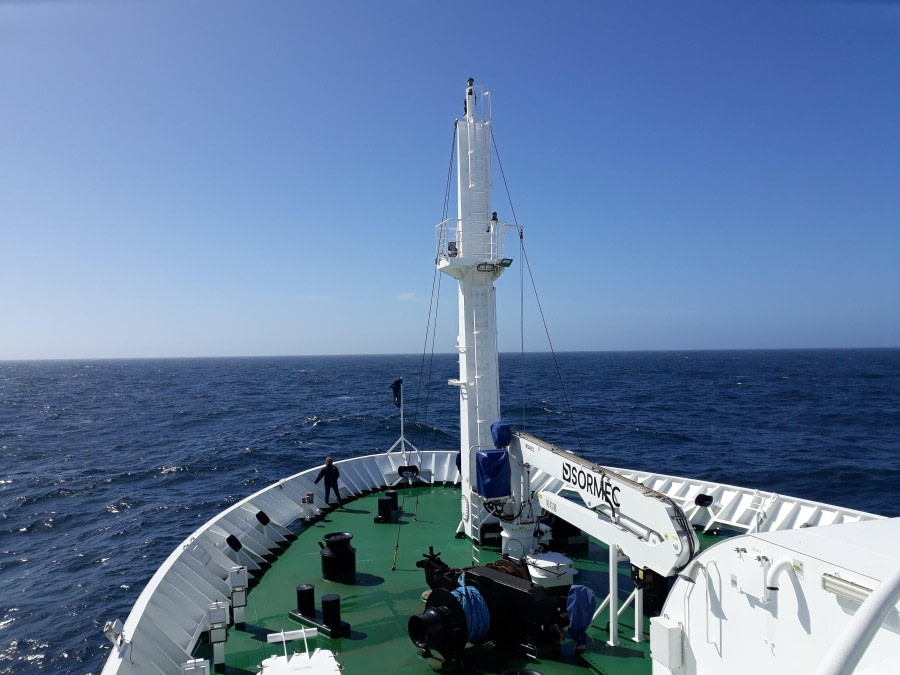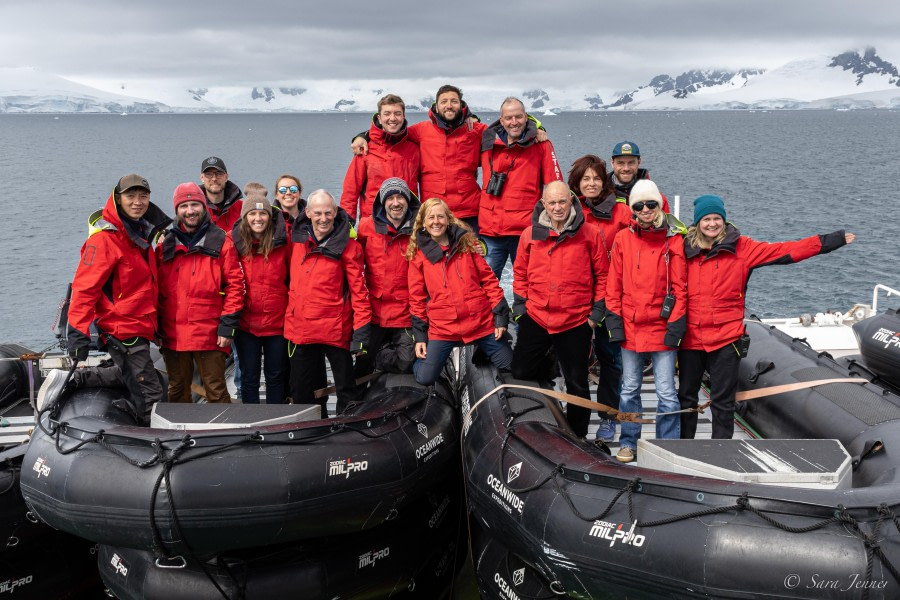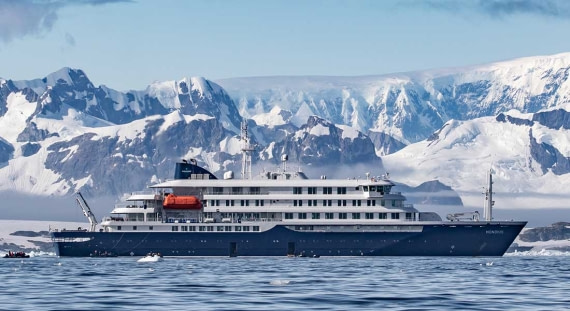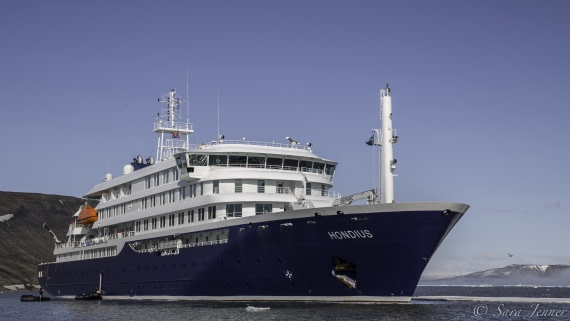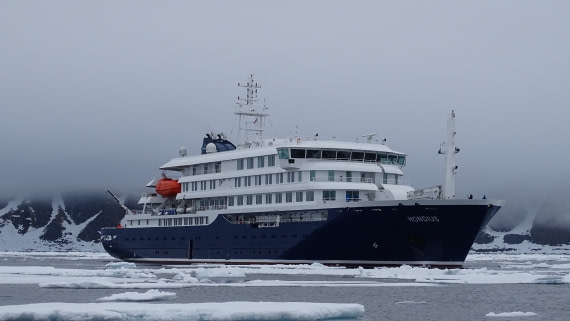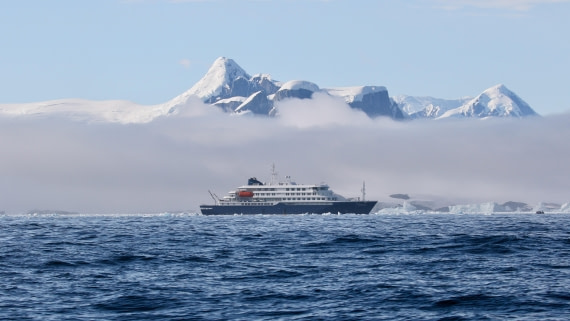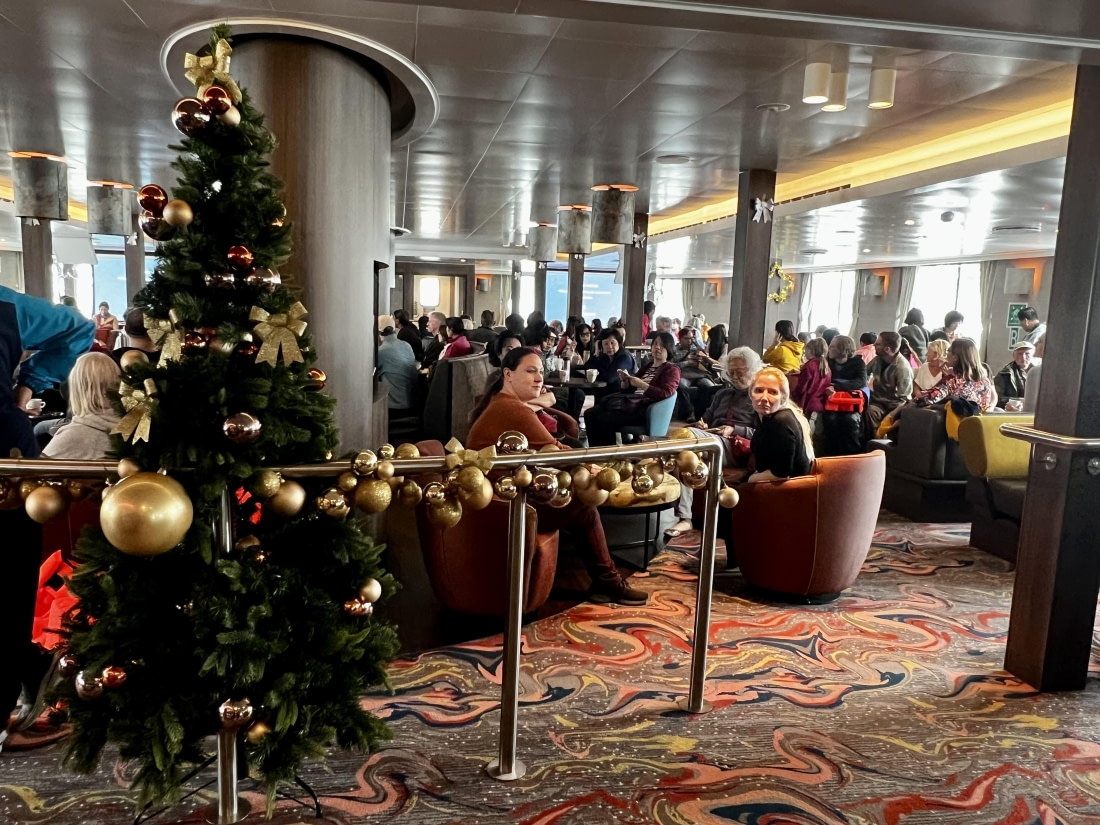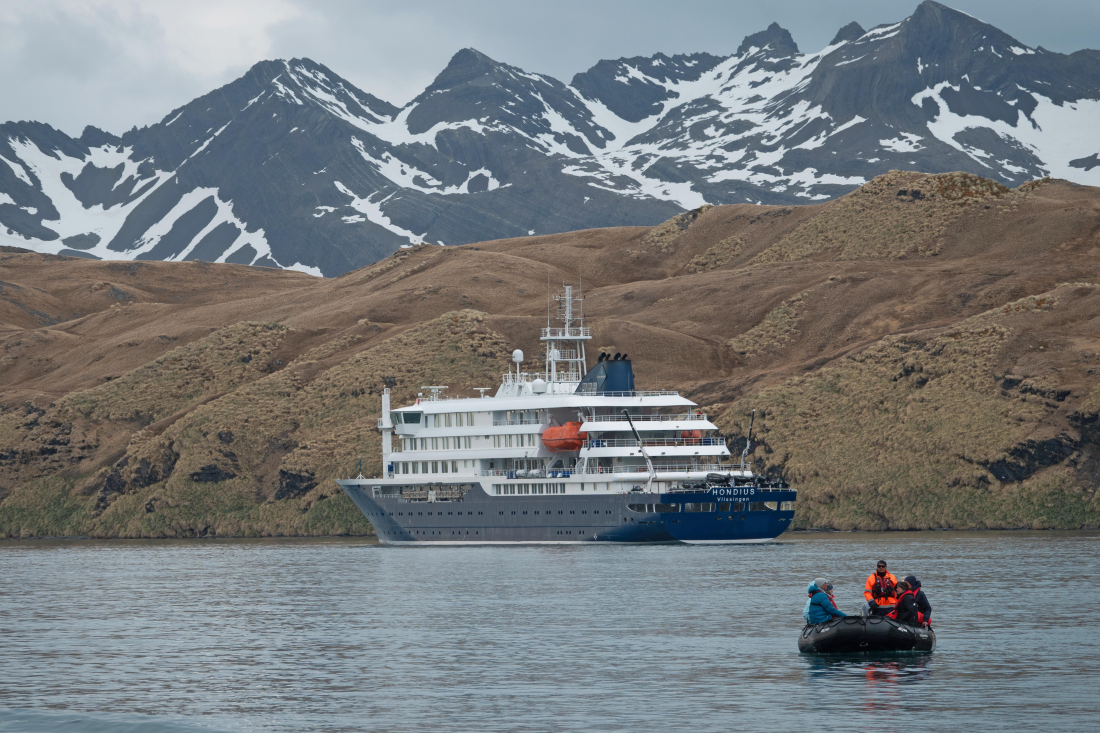| Datum: |
19.12.2023 |
| Positie: |
55°20,4' S / 060°25,0' W |
| Wind: |
W 4 |
| Weer: |
Zonnig |
| Luchttemperatuur: |
+12 |
Sara stond tegen het dashboard geleund. Door de ramen van de brug van de kapitein waren de wazige contouren van naderend land te zien. Het Hondius-schip, dat zachtjes heen en weer zwiepte en met zijn krachtige boeg door de golven sneed, naderde de Falklandeilanden (Malvinas).
De lucht was gehuld in een lichte nevel, maar de kracht van de zon die er doorheen brak was genoeg om objecten een vage schaduw te laten werpen. De frisse rugwind deed de golven af en toe schuimen. De expeditie was net begonnen en we bevonden ons nog steeds op gematigde breedten, dus als je het dek opstapte voelde je de wind, sterk en behoorlijk koel, maar nog niet ijskoud.
Precies een kwartier voor het ontbijt, om 6:45 uur, kwam Sara fluisterend "Nou, vrienden, laten we beginnen" naar de microfoon toe, drukte op de luidsprekerknop en begon haar ochtendtoespraak: "Goedemorgen, goedemorgen, goedemorgen..." Tijdens het ontbijt voelden velen van ons een lichte opwinding, want het was onze eerste volledige expeditiedag. Er waren twee landingen gepland voor die dag: 's ochtends op het eiland met de onheilspellende naam Carcass Island en na de lunch op een ander eiland, Saunders Island genaamd. Hondius liet het anker vallen en zeilers lieten verschillende Zodiacs in het water zakken. Alle leden van het expeditieteam stapten in deze zwarte opblaasbare motorboten en haastten zich met alle benodigde uitrusting naar de kust, waarbij ze wolken van nevel veroorzaakten. Het bleek een routineprocedure te zijn: eerst landt het expeditieteam, beoordeelt de situatie en de weersomstandigheden en dan geeft de expeditieleider ons het "groene licht" om de ijzeren dekken van het schip te verruilen voor de vaste grond van het land.
We verzamelden in de Zodiac boarding area en in kleine groepjes van tien begonnen we aan boord van de Zodiacs te gaan. Zodra alle zitplaatsen in de boot bezet waren, zette de Zodiac zich onder leiding van een ervaren gids in beweging. Snel tempo makend, raasde hij naar de kust. De zon speelde op de golven, de motor bulderde, spetters vlogen alle kanten op, het regende als regen op ons en versterkte het gevoel van avontuur dat we beleefden. Voor degenen die vanaf het dek naar ons keken, leken de Zodiacs op ondeugende kinderen die, zodra de regen ophield, naar buiten stormden en met hun kinderlijke voeten door plassen renden, spetters veroorzaakten en volwassenen met hun hoofd deden schudden en met hun vingers lieten kwispelen.
Aan wal stonden Sara, William, Jerry, Jakub en andere leden van het expeditieteam al op ons te wachten. De Zodiacs zakten in het witte zand van de Falklandeilanden en één voor één klommen we op de oever en zwaaiden onze benen over de rand. De lage, maar pittige golven sloegen onophoudelijk tegen de achtersteven van de Zodiacs, alsof ze ons aanmoedigden, ze bespoten ons met spetters en spatten zelfs overboord, waardoor de Zodiac-bestuurders mopperden en ons voortjoegen.
Het zandstrand werd vervangen door plukjes polgras naarmate we verder landinwaarts trokken. Soms moesten we door moerassige gebieden stappen. De lucht rook tegelijkertijd naar zee, gras en turf - een zeer ongebruikelijke combinatie van natuurlijke aroma's.
Nadat we door een dichtbegroeide grasgrot waren gelopen, bevonden we ons weer op het strand, maar aan de andere kant van het eiland. Het was, moet ik zeggen, veel pittoresker dan het strand waar we in eerste instantie waren geland, niet alleen omdat de zandstrook veel breder was, maar ook omdat het strand bruiste van een groot aantal vertegenwoordigers van de lokale fauna.
Op een kleine heuvel, alles overziend met hun trotse blik, stond een familie ganzen. Het mannetje en vrouwtje waren even groot, maar verschilden sterk in de kleur van hun veren: de ene was helemaal bedekt met sneeuwwitte veren en de andere had bruine veren, maar de borst was gespikkeld met een dunne zwart-witte streep. De kuikens waren allemaal egaal grijs. Ze betraden de grond met hun kleine stapjes en bogen voortdurend hun kopjes naar de grond, terwijl ze eetbare vegetatie plukten met hun scherpe snavels.
Op de golven slingerde een paar Steamer eenden. Het mannetje had een oranje snavel en het vrouwtje een groene. Deze vogels konden allang niet meer vliegen. Waarom moeite doen? Het klimaat is hier gunstig, zonder sterke temperatuurschommelingen, dus het is niet nodig om te migreren. Al hun voedsel ligt recht voor hun neus, ze hoeven er niet voor te vliegen, en het nest is op loopafstand, slechts enkele tientallen meters van de kustlijn. Het meest grappige aan stoomeenden is hoe ze kwaken. Nee, het is geen kwaken; het lijkt meer op een kruising tussen het getjilp van een cicade en de geluiden uit een oud computerspel uit begin jaren 90.
En hier zijn onze eerste pinguïns - Magelhaenpinguïnen! Ze zijn vrij klein, eigenaardig, waggelen voortdurend en helpen zichzelf met hun vleugels. Toch laten ze zich er helemaal niet door hinderen, ze slenteren over het strand en kijken in verschillende richtingen. In plaats van nesten te bouwen, graven ze diepe holen en zitten daarin te wachten op de komst van hun kroost. Ja, het is donker en vies, maar geen enkele jager zal ooit hun eieren stelen. Nou ja, behalve als er af en toe een nieuwsgierig pinguïnkuiken per ongeluk aan de oppervlakte komt om te zien wat er achter het hol ligt - en hier beginnen de problemen. De kwaadaardige jager heeft dat maar nodig, duikt meteen naar beneden, grijpt het kleintje en klaar is kees. Hij gaat ergens op een rots zitten en pikt naar zijn bloedige vangst.
We hadden nog een lange wandeling voor de boeg. Drie tot vier kilometer van de landingsplaats stond een gehucht. De plaatselijke bewoners, de eigenaars van het eiland, woonden er al heel lang, hielden schapen en vingen vis. Rond de huizen lag een tuin met bloemen en schaduwrijke naaldbomen. Elke keer als er reizigers op hun eiland aankwamen, bakten ze honderden gebakjes en cakes en trakteerden ze alle gasten. Dat was deze keer ook zo, maar voordat we thee konden drinken en ons tegoed konden doen aan de lokale gebakjes, moesten we, zoals eerder gezegd, eerst een stuk afleggen.
Het pad liep langs de helling van de heuvel langs de kust. Rechts van ons graasden schapen en fladderden lokale vogels rond, terwijl links de baai van Carcass Island zich uitstrekte, in het midden waarvan ons schip Hondius trots en zelfverzekerd voor anker lag. De zon overgoot ons met ultraviolet en warmte, waardoor het heet werd. Sommigen van ons moesten stoppen om truien of jassen uit te trekken.
Toen we het huis bereikten, nestelden we ons in de schaduw van de bomen. Een voor een gingen we het huis binnen om een gebakje of koekje van de tafel te pakken, een kopje thee in te schenken en dan weer naar buiten te gaan, zittend op een bankje of een boomstam, de vaardigheid van de plaatselijke banketbakkers waarnemend. De ochtend ging snel voorbij. Kijk, het is al bijna middag! Het is tijd om terug te keren naar het schip! De Zodiacs lagen al op ons te wachten bij een kleine betonnen pier. We deden zwemvesten aan, stapten in de boten en haastten ons terug aan boord van de Hondius. Gebak is ongetwijfeld lekker, maar een uitgebreide lunch is nog lekkerder!
Terwijl we ons verzamelden voor de lunch, haalden de matrozen het anker op en ging ons schip op weg naar onze locatie voor de middagactiviteit - het Saunders-eiland. Het was niet ver weg, dus we hadden niet meer dan een uur om uit te rusten na de lunch, en nog minder voor onze gidsen. Zodra de ankerketting klapperde, gingen de dappere deelnemers van ons expeditieteam aan boord van de Zodiacs en zetten koers naar de kust van Saunders Island om wat voorbereidingen te treffen voor onze landing. Vrolijke Kortsnuitdolfijnen, blij dat de gasten eindelijk waren aangekomen, sprongen speels uit het water en organiseerden een ere-escorte voor de Zodiacs tot aan de kust.
Enige tijd later werd de officiële start van de operatie gegeven. Zodiac na Zodiac raasden we over het gladde water en zodra we de kust bereikten, gingen we van boord, waarbij we ons haastig ontdeden van de zware reddingsvesten. Wit fijn zand, rustig water en... pinguïns! Die staarden ons verbijsterd aan, flapperden met hun eigenaardige vleugels en probeerden te begrijpen wie we waren en wat we wilden.
De plaatselijke bewoners, de eigenaars van Saunders Island, arriveerden in twee auto's om ons persoonlijk te ontmoeten en te begroeten. Ze parkeerden hun auto's bij de kustlijn, openden hun kofferbak en boden ons enkele interessante souvenirproducten aan.
Het pad was al gemarkeerd. Er wachtte ons een wandeling van anderhalf tot twee kilometer langs de kust. Ezelspinguïnen zaten op hun nesten van modder en gras en waakten over hun kuikens. De kuikens waren al vrij groot en sommige van hen, moed verzamelend, maakten korte wandelingen rond hun nest. De ouders bewaakten hen ijverig, klapten en blokkeerden hun weg met hun vleugels: "Stil, stil, blijf, waar ga je heen? Nee, het is nog te vroeg voor jullie!" Het was amusant om te zien hoe ze hun nek naar ons toedraaiden, met hun snavels klikkend, alsof ze tegen ons zeiden: "Doorlopen, jongens, we hebben hier al genoeg problemen!" En inderdaad, ze hadden genoeg problemen. Er cirkelden voortdurend gemene roofmeeuwen boven ons, die de pinguïnkolonie scherp in de gaten hielden. God verhoede dat een pinguïn onoplettend zou zijn; onmiddellijk zou een roofmeeuw neerduiken en een pinguïnkuiken grijpen! Hij greep het in zijn snavel en droeg het weg naar een plek waar nog nooit een pinguïn was teruggekeerd. De natuur is hier wreed, maar wat kun je doen.
Hier is de kolonie Magelhaenpinguïnen. Net als hun soortgenoten die we 's ochtends zagen, zaten deze ook in hun holen, verteerd door nieuwsgierigheid, naar buiten te gluren en naar ons te kijken.
Op de helling, beter te omschrijven als een "klif", zat een kolonie kuifaalscholvers, en vlak naast hen werd een stuk land opgeëist door Rotspinguïnen. Kleine, behendige herrieschoppers, die hun naam eer aan deden, waren constant in beweging en huppelden van rots naar rots. We bleven een hele tijd bij ze staan om foto's te maken en hun bedrijvigheid te observeren. Maar het belangrijkste wachtte nog op ons.
Uiteindelijk leidde het pad ons naar een kolonie Wenkbrauwalbatrossen. Deze enorme en majestueuze vogels zaten in nesten met een perfecte cilindrische vorm. De meeste albatrossen hadden hun jongen al grootgebracht. Het was niet eenvoudig om een albatroskuiken te vinden. We moesten wachten tot de ouder op zijn poten stond en dan pas konden we het kleine grijze levende bundeltje eronder zien. Sommige albatrosouders lieten hun kuikens de buitenwereld bewonderen en hielden ze knus onder hun vleugels.
Ouderlijke plichten wogen zwaar op de albatrossen. Zittend in hun nesten keken ze verlangend naar de zee, dromend van het moment dat ze eindelijk hun enorme vleugels konden spreiden en, de wind bedwingend, over de golven de verte in konden zweven. Albatrossen zijn gemaakt om te vliegen en alleen het oeroude instinct, zo oud als de aarde zelf, dwong hen om stil in het nest te blijven zitten en voor hun kroost te zorgen. Sommige albatrossen maakten lange, treurige geluiden, waarschijnlijk om de emoties uit te drukken die zich in hen hadden opgehoopt. Terwijl ze de veren van hun kuikens presten, leek het alsof ze in hun oren fluisterden: "Groei snel op, dan vliegen we samen! Ik zal je laten zien hoe het maanlicht op de golven van de zee speelt en hoe walvissen fonteinen in de lucht schieten. Ik zal je leren om de wind uit te dagen en inktvissen te vangen!" Oh, kon het maar sneller! Onze gidsen lieten ons zien waar we de beste foto's konden maken en zorgden ervoor dat niemand van ons, opgaand in het spektakel, van de klif viel. Albatrossen die naar ons keken, fronsten hun wenkbrauwen maar poseerden toch voor foto's.
Nadat we ons tegoed hadden gedaan aan albatrossen, begonnen we aan onze terugreis. Op de terugweg naar de landingsplaats hadden we de gelegenheid om rechtsaf te slaan en ons op een ander strand te bevinden, tegenover het strand waar we aankwamen. Witte, torenhoge golven, onheilspellend brullend, beukten op het zand. Onverschrokken stormden Magelhaenpinguïns en Ezelspinguïnen erop af en verdwenen in het witte schuim. Sommige pinguïns daarentegen kwamen tevoorschijn uit het zeeschuim, alsof Venus zelf, nadat ze gezwommen en gejaagd had, in het witte schuim verscheen, op weg naar hun nesten om van plaats te ruilen met hun partner en hen zo de kans te geven om in zee te gaan jagen.
Maar welke pinguïns staan daar bij de kustlijn? Oh, dat zijn de Koningspinguïnen! Het waren er maar een paar, sommige nog kuikens getooid in enorme, lompe bruine pyjama's van zachte, warme veren. Wat een verrassing! Natuurlijk probeerden we allemaal ten minste een paar foto's van deze magische wezens te maken.
Langs de pinguïns liepen kelpmeeuwen en Dolfijnmeeuwen. Ze draaiden hun kop om en pikten herhaaldelijk in het zand om de schaaldieren die zich erin verstopten te verorberen. Tussen kleine zandduinen wandelden oestervangers, die ons verbaasden met hun lange felrode snavels. Rustig, heen en weer schommelend, slenterden hier en daar stoomeenden. Een Kleine Zwaan cirkelde boven ons en, net als aan het begin van onze wandeling, zweefden jagers en caracara's in de lucht en joegen alle andere gevederde bewoners van Saunders Island de stuipen op het lijf.
Op de hellingen van de heuvel graasden schapen die af en toe de aandacht trokken met luid geblaat. In de lokale omgeving leken ze ons te zien als iets vreemds, zo niet buitenaards, dan toch zeker als iets dat totaal niet in harmonie was met het omringende landschap.
Hoe dan ook, het was tijd om terug te keren naar het schip. Zodra de laatsten aan boord waren, zette de Hondius koers naar Stanley, de hoofdstad van de Falklandeilanden (Malvinas). Naar mijn mening een heel behoorlijke eerste dag van de expeditie, vind je ook niet?
